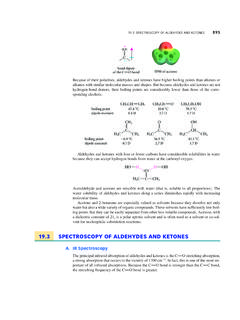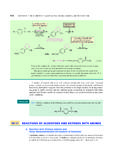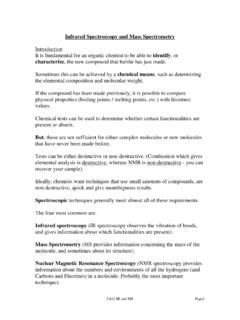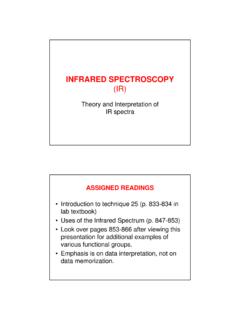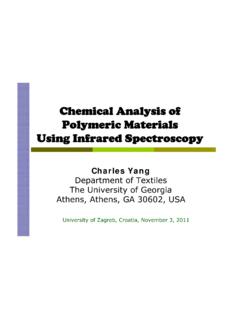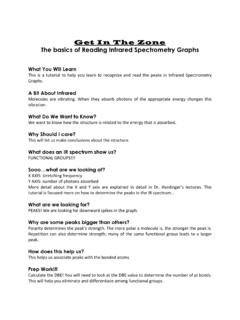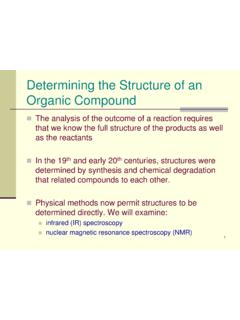Transcription of lecture 7 (stu - University of Birmingham
1 lecture 7 Imines, Hydrazones and OximesObjectives:By the end of this lecture you will be able to: draw the mechanism for imine formation; account for the decreased electrophilicity of C=N compounds; use frontier molecular orbitals to account for the increased nucleophilicity of hydroxylaminesand hydrazines over alkoxides and amines; draw the mechanism for oxime and hydrazone formation; use 2,4-dinitrophenylhydrazones for characterising aldehydes and ketones; use the Beckmann rearrangement for preparing amides from carbonyl group (C=O) is the most important C=X functional group. However X can be otherheteroatoms such as N and S. In this lecture we will examine the formation of a variety of C=Nfunctional groups and compare their reactivity with their oxygen reaction of primary amines with aldehydes and ketones under dehydrating conditionsgenerates the corresponding imine.
2 The mechanism is a variation of the nucleophilic addition-elimination reaction that we have discussed for carboxylic acid derivatives. You should compare the first few steps with those in the hydration of aldehydes and ketones;the mechanisms are identical. The reaction is normally acid-catalysed (Lewis or Br nsted). Whilst primary amines arerelatively good nucleophiles, without some activation of the carbonyl group, nucleophilicaddition is generally slow. Note that primary amines are also much more basic than the carbonyl oxygen (pKa(RNH3+) ~11; pKa(R(C=OH)+R) ~ -6) so for the most part the amine will be protonated making it non-nucleophilic). Under acidic conditions, the rate-determining step is not surprisingly the addition reaction toform the first tetrahedral intermediate.
3 Imine formation can also be carried out under neutral or basic reaction conditions. In thesecases, the dehydration step is rate-determining. The reaction is an equilibrium process and if anything, thermodynamically uphill (C=N bond isweaker than C=O bond). Therefore to drive the reaction over to product it is normal to use anexcess of amine and remove the water from the reaction mixture as it is formed in thedehydration step. This can be achieved in a variety of ways including using a dehydratingagent in the reaction mixture ( MgSO4), or by azeotropic removal of water using Dean-Stark are less electrophilic than aldehydes and ketonesThe decreased electrophilicity of imines is readily accounted for by the lower electronegativity ofnitrogen compared with that of of oxygen on the Pauling scale = of nitrogen on the Pauling scale = of carbon on the Pauling scale = a result of the reduced electronegativity of the heteroatom, the double bond in an imine is lesspolarised.
4 There is therefore a weaker dipole moment across an imine than across thecorresponding carbonyl is therefore less + charge at the imine carbon atom which makes it less electrophilic; thuswhilst imines do react with nucleophiles in a similar fashion to carbonyl groups, they tend torequire strong nucleophiles and more forcing reaction that under acidic conditions imines can be activated in a similar way to since the imine nitrogen is more basic than the oxygen in a carbonyl group, theequilibrium lies more towards the reactive iminium species, than it does in the correspondingcarbonyl series:Hydrazones and OximesHydrazines and hydroxylamines both react with aldehydes and ketones to provide hydrazonesand oximes, respectively.
5 Although both these reagents are more nucleophilic than the parentamine, they still react better under acid or base catalysis. The mechanism is analogous to thatused to form Issue of StereochemistrySince imines, hydrazones and oximes have substituents off both ends of the C=N double bond,there is an issue of stereochemistry that needs to be considered, just as there is for anyunsymmetrically substituted double imines and hydrazones the energetic barrier to (E)-(Z) isomerisation is sufficiently low for it tobe relatively difficult to isolate (E)- or (Z)-stereoisomers. That is not to say, of course that onestereoisomer does not predominate in the equilibrium. On steric grounds the (E)-stereoisomer isnormally the major the case of oximes, the barrier to interconversion between the two stereoisomers is muchhigher and allows the isolation of the two stereoisomers.
6 As before, minimising steric hindrancenormally ensures that one stereoisomer ,4-DinitrophenylhydrazonesBefore the advent of modern analytical techniques such as NMR spectroscopy and massspectrometry, chemical derivatisation was commonly used to identify unknown aldehydes and ketones are usually liquids. Reaction with 2,4-dinitrophenylhydrazinegenerates the corresponding 2,4-dinitrophenylhydrazone (2,4-DNP derivative) which is usually abright yellow crystalline solid possessing a characteristic melting point. Comparing the meltingpoint of an unknown 2,4-DNP derivative with those in lists of tables of known DNP derivativesallows the identification of the parent aldehyde or of OximesConsider the reaction of two stereoisomeric oximes with para-toluenesulfonyl chloride (TsCl).
7 The outcome is strongly dependent on the configuration of the oxime. When the (E)-stereoisomer is used, an amide is obtained through a reaction known as the Beckmannrearrangement. When the (Z)-stereoisomer is used, an elimination reaction proceeds to providethe corresponding outcome of the reaction is determined by the type of group that is antiperiplanar to of the Beckmann RearrangementThe key step in the reaction is migration of the antiperiplanar group on to the nitrogen withconcomitant displacement of the tosylate leaving group. The incipient positive charge is thentrapped with water and a series of proton transfer steps provides the corresponding of a nitrile from the (Z)-stereoisomerThis reaction is effectively an E2-elimination reaction.
8 The antiperiplanar group is a hydrogensubstituent, which, rather than migrating, is abstracted by an external base:Why are hydrazines and hydroxylamines more nucleophilic than amines?It is a general observation that heteroatoms bonded directly to another heteroatom ( and hydrazines) exhibit increased nucleophilicity compared with the parentsystem where the heteroatom substituent is replaced with a carbon can rationalise this observation by examining the important frontier molecular orbital of thenucleophile, specifically the Highest Occupied Molecular Orbital (HOMO).In general the higher is the energy of the HOMO of a nucleophile the greater is its reactivity as anucleophile. The presence of a heteroatom substituent possessing a lone pair of electrons in anorbital that can overlap with the lone pair of electrons on the adjacent heteroatom raises theenergy of the HOMO and therefore renders it more nucleophilic.
9 This is a general observationand is known as the the carbonyl oxygen with a nitrogen atom affords a related class of compounds:imines, hydrazones and oximes. All three can be prepared from the parent aldehyde or ketoneand a nitrogen nucleophile: primary amines provide imines, hydrazines provide hydrazones, andhydroxylamines give mechanism for forming of C=N derivatives is similar to the nucleophilic addition-eliminationprocesses seen with carboxylic acid derivatives. An initial nucleophilic addition step is followedby dehydration. The reaction is catalysed with acid or base. The rate-determining step dependson the pH of the reaction. Under acidic conditions, the RDS is the initial addition reaction to formthe tetrahedral intermediate, whilst under basic conditions dehydration is derivatives are less electrophilic than their carbonyl analogues owing to the decreasedelectronegativity of nitrogen compared with oxygen.
10 This renders C=N derivatives lesssusceptible towards nucleophilic presence of a substituent on the nitrogen of imines, hydrazones and oximes means that twostereoisomers are possible for compounds derived from aldehydes and unsymmetricallysubstituted ketones. In the case of imines and hydrazones, the energy barrier to interconversionis relatively low such that stereoisomerically pure derivatives are not easy to isolate - thestereoisomers are not configurationally stable. In contrast, the barrier to interconversion betweenoxime stereoisomers is high and the two stereoisomers can often be separated and isolated asstereoisomerically pure species. The (E)-stereoisomer is normally the predominant ,4-Dinitrophenylhydrazones have been widely used in the past for elucidating the structure ofaldehydes and ketones.

